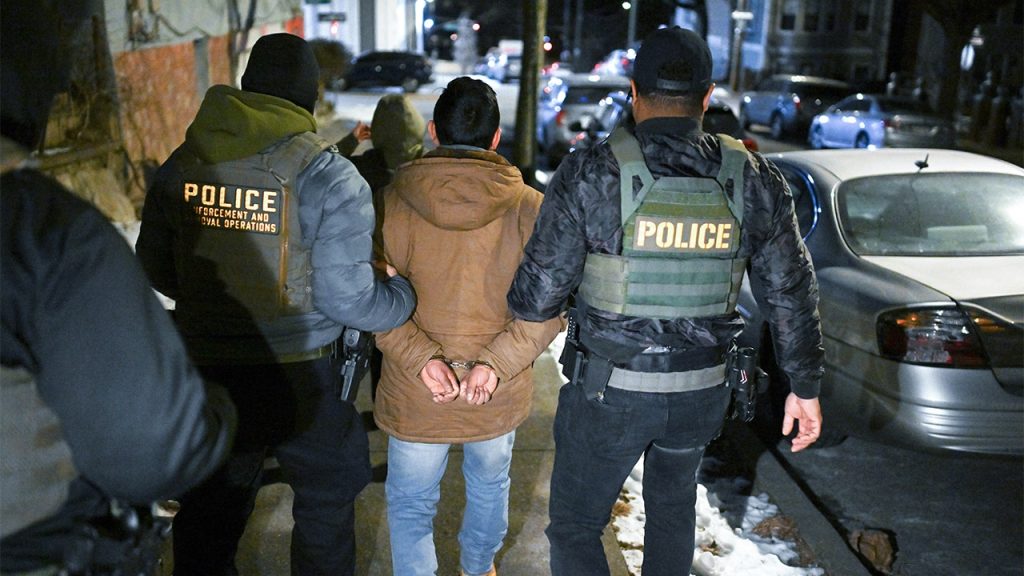Immigration and Customs Enforcement (ICE) is set to enhance its operations with the imminent reopening of the Delaney Hall facility in Newark, New Jersey. This facility, which will serve as a processing and detention center with a capacity of up to 1,000 beds, marks a significant step in the Trump administration’s deportation efforts. Acting ICE Director Caleb Vitello stated this expansion is part of a broader initiative to increase enforcement against illegal immigration in the United States.
| Article Subheadings |
|---|
| 1) Overview of Delaney Hall Reopening |
| 2) Impact on Detention Capacity and Operations |
| 3) Recent Arrest Statistics |
| 4) Changes in Immigration Policies |
| 5) Conclusion About Future Enforcement Actions |
Overview of Delaney Hall Reopening
The decision to reopen the Delaney Hall facility signifies a renewed focus on immigration enforcement by ICE. The facility’s reopening comes as part of a strategic plan to ramp up deportation efforts, which have seen significant changes under the latest administration. Acting ICE Director Caleb Vitello emphasized that the location’s proximity to an international airport will enhance logistics and facilitate quicker processes for detained individuals. This move is anticipated to address the growing needs of the enforcement and removal operations in the Northeast region of the United States.
Impact on Detention Capacity and Operations
The reopening of Delaney Hall is expected to expand ICE’s capacity to detain individuals facing deportation. Currently, ICE has under 42,000 detention beds, and facilities have been operating beyond capacity. The agency aims to utilize the additional 1,000 beds offered by the Delaney Hall facility to alleviate overwhelming demands. With the rising numbers of arrests and detentions, it becomes increasingly crucial to manage these operations effectively. By increasing bed space, ICE intends to bolster its ability to fulfill the enforcement mandates outlined by the Trump administration.
Moreover, the agreement with the facility’s owner marks the agency’s commitment to rebuilding its operational capabilities previously affected by the former administration’s policies. With the Trump administration advocating for stringent enforcement, resources are being mobilized to support this increased focus on immigration control.
Recent Arrest Statistics
Recent data published by the Department of Homeland Security highlights a 137% increase in ICE arrests, exemplifying the agency’s intensified enforcement efforts. From January 20 to February 8, ICE recorded 11,791 interior arrests compared to just 4,969 during the same period in the previous year. This spike points to the renewed enforcement strategies being implemented, driven by the administration’s commitment to crack down on illegal immigration.
The impact of these arrests is significant for local communities, particularly in regions with high concentrations of undocumented immigrants. Such increases in enforcement activities may lead to heightened apprehensions and community tensions, prompting local leaders to respond in various ways, including partnerships with ICE or policies that could restrict cooperation with federal authorities.
Changes in Immigration Policies
Under the current administration, notable changes have been made to immigration policies that facilitate increased deportation efforts. One significant change is the removal of restrictions that previously limited ICE agents’ operations, particularly those imposed during the prior administration. For instance, the reinstatement of expedited removals allows ICE to expedite the deportation process for certain undocumented immigrants.
Additionally, the administration is moving to end Temporary Protected Status for certain populations, which historically allowed individuals from specific countries to reside in the U.S. during adverse conditions. These policy shifts aim to create a more favorable environment for enforcement activities, potentially leading to a more significant number of deportations.
Furthermore, the administration is engaging in negotiations with other nations to enhance their border security capabilities and agree to repatriate undocumented immigrants effectively. These agreements are crucial in streamlining the deportation process and ensuring that individuals apprehended by ICE can be promptly returned to their home countries.
Conclusion About Future Enforcement Actions
The reopening of Delaney Hall reflects a broader strategy within the Trump administration to tackle illegal immigration head-on. As ICE ramps up its operations, communities and policymakers are left to navigate the consequences of these intensified enforcement measures. Moving forward, one can expect to see a continued focus on bolstering detention capacity and streamlining the deportation process while addressing logistical challenges inherent in such operations.
The administration’s approach emphasizes a commitment to eliminating illegal immigration, capturing public attention on related humanitarian and social issues. The outcomes of these policies are likely to shape the national conversation around immigration in the coming months, influencing legislative and community responses nationwide.
| No. | Key Points |
|---|---|
| 1 | Delaney Hall facility reopens to enhance ICE’s detention capacity. |
| 2 | ICE has recorded a significant increase in interior arrests. |
| 3 | New policies facilitate increased deportation efforts by ICE. |
| 4 | The administration engages in international negotiations to enhance border security. |
| 5 | Community impacts and responses to increased ICE enforcement activities. |
Summary
The reopening of the Delaney Hall detention facility marks a decisive shift towards aggressive immigration enforcement under the Trump administration. With significant increases in arrests and strategic policy adjustments, the future landscape of immigration enforcement in the U.S. appears poised to change dramatically. As enforcement actions ramp up, the repercussions echo through communities, raising critical conversations about immigration policy and its implications for the American social fabric.
Frequently Asked Questions
Question: What is the purpose of reopening the Delaney Hall facility?
The reopening aims to enhance ICE’s capacity to detain individuals facing deportation and streamline the processing of these cases.
Question: How has the recent arrest rate changed compared to previous years?
Recent statistics show a significant increase, with ICE reporting a 137% rise in interior arrests within a specific timeframe compared to the previous year.
Question: What changes have been made to immigration policies under the new administration?
The administration has removed restrictions on ICE operations and is implementing measures such as ending Temporary Protected Status for certain nationalities, which facilitates increased deportation efforts.


